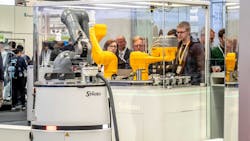Cobots have significantly changed the industrial landscape by allowing robots and humans to work closely without putting people in danger. It wasn’t long ago that the only way to work with robots was to keep the machines behind safety cages. Now, robots designed specifically to collaborate with humans can work only inches from them. The associated advancements became even more impressive when cobot manufacturers used artificial intelligence (AI) to improve their models.
What can AI do when integrated into a cobot? Here are the benefits—and why they’re important for pushing AI and robotics forward.
AI Helps Cobots Perceive Their Surroundings
Awareness of surroundings is one of the most critical capabilities in collaborative robots. These machines often work in busy environments filled with humans, vehicles and shelves stacked with products. People also frequently use them to do tasks that require holding objects or using tools. These applications require robots to detect obstacles in their environment and respond accordingly.
AI is typically the technology that allows those things to happen. For example, 3D machine vision enables cobots to detect an object’s size and shape, as well as its orientation and depth. That improvement is notable because it creates more opportunities for cobot applications. Some companies use collaborative robots that stay in one place throughout the workday. Someone might work side-by-side with a robotic arm to do a repetitive task.
READ MORE: How TIG Welding Cobots Support an Automation Enhanced Workforce
However, it’s increasingly common for company decision-makers to invest in mobile cobots that roam around a facility without ongoing human input. Machines in these situations must respond to continually changing environments. They might slow down when a human passes in front of them or steer around obstacles in their path. Some even know when their batteries are low and return to charging points as needed.
AI makes cobots fit for purpose in high-traffic environments, ensuring the machines can navigate safely and efficiently without causing hassles that could slow down workflows. Artificial intelligence also makes it relatively easy for a user to teach a cobot about its surroundings. Once the machine maps the environment, it can respond to minor changes without retraining.
AI Enables Cobots to Work Productively
Many people worry that robots will take over their jobs. Indeed, some robotics can do advanced manufacturing tasks, such as welding. However, what often happens when company leaders purchase AI-powered cobots is that those machines supplement what people do, creating overall better outcomes.
Consider the results of a study that created three teams to do transport-related tasks. One group was all robots, another was all humans and the third was a mix of both. The results showed that the mixed team coordinated their processes most effectively, resulting in the best efficiency and fewer accidents.
READ MORE: The Robots Have Eyes
AI cobots rely on advanced algorithms to work. That often means the machines get better with use as the algorithms receive more data about what constitutes ideal performance. That’s one of the reasons why manufacturing leaders often purchase robots to do repetitive tasks. One example came from a Dutch manufacturer of sinks and bathtubs. A representative explained that employees preferred not to do manual labor all day since it was boring. The company’s cobots sand products and humans switch out the sandpaper as needed.
Researchers at Carnegie Mellon University also developed an algorithm that could advance human-cobot teamwork even more. It’s a planner they call Act, Delegate or Learn. The algorithmic planner studies tasks to determine how they should be completed. Should a robot handle the job, assign it to a human or learn to do it?
The researchers tested their algorithm by having robots push blocks onto a peg board or differently sized and shaped Lego bricks. The results showed that this algorithm could be particularly useful for manufacturing, assembly, package-sorting, or any other setting requiring humans and machines to frequently collaborate on their tasks.
AI Keeps Cobots Safe Around Humans
Company leaders often purchase cobots after they realize their human workforce can’t meet needs. That was one of the effects of the COVID-19 pandemic, especially as social-distancing requirements reduced the number of people on shift at any given time, all while the demand for specific products rose sharply.
In one case, an order-fulfillment company experienced a 30% business increase in 60 days. Collaborative robots halved the number of people required to handle each order. Statistics also indicate companies can achieve a 40% increase in output by replacing one key person with a robot.
Cobots support safety when companies must ramp up production to stay competitive. They have built-in components, such as sensors, that make them slow or stop if humans get in the way. Many also have soft parts so people don’t get hurt and are undamaged if a collision occurs.
READ MORE: What You Need to Know About Mobile Robots
These machines already have AI features to maintain safety. However, researchers are also investigating how artificial intelligence might bring further improvements. Humans should feel increasingly comfortable working around robots during various tasks if that happens.
For example, KTH Royal Institute of Technology researchers want to create context-aware cobots to predict a worker’s next pose. The machines can also understand someone’s current position. They use less computationally intensive artificial intelligence that works with smaller data batches than traditional machine learning models.
Researchers at the University of British Columbia’s Okanagan campus are developing robots that can perceive their environments similarly to humans. They envision a future where humans and machines can work safely together, even outside the confines of an environment such as a factory. Many people are already experimenting with using cobots on construction sites or giving them perimeter-security tasks. Technological advancements in human-robot collaboration could make those duties even safer for everyone involved.
Cobots are Better With AI
Innovations in artificial intelligence are largely responsible for how safe, capable and feature-filled cobots have become. AI makes robots suitable for various tasks and gives company leaders the peace of mind that comes from knowing these machines can work safely and productively around humans.
As researchers continue to explore how to use AI in new, boundary-pushing ways, we can look forward to more fascinating cobot-related achievements. Conversely, when designers, engineers and others apply AI to their cobot projects, they’ll likely discover other intriguing ways to use the technology outside collaborative robots.
Emily Newton is a technology and industrial journalist. She is also the editor-in-chief of Revolutionized. She has more than five years covering stories about warehousing, logistics and distribution.
About the Author

Emily Newton
Emily Newton is a technology and industrial journalist. She is also the editor in chief of Revolutionized. She has over five years covering stories about warehousing, logistics and distribution.
